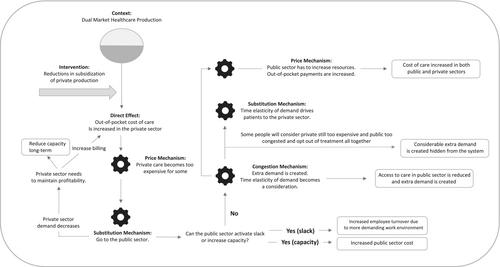The Finnish dental care market operates as a dual system, divided between a regulated, affordable public sector and a less regulated, more expensive private sector that receives public subsidies. In 2015 and 2016, two policy interventions were introduced to reduce these subsidies for private dental services. The aim of this study was to evaluate the impact of these policy changes on the dental care market.
This study was a realist evaluation. Context-Intervention-Mechanism-Outcome-configurations were applied to elicit an initial program theory (IPT) for the policy interventions. The IPT allowed a complicated system to be reduced to the main components, allowing for better understanding of the underlying mechanisms and the chain of events started by the interventions. The resulting hypotheses about the chain of events and outcomes were tested against a dataset collected from the Social Insurance Institution of Finland (SII) registries on public and private dental visits in the cities of Espoo, Helsinki and Oulu during the years 2010–2016. The used dataset consisted of N = 17 111 625 dental procedures or N = 8 139 990 individual visits (which can include several procedures) at a public (n = 9 097 407 procedures, n = 4 083 475 visits) or a private (n = 8 014 218 procedures or n = 4 056 515 visits) dental clinic. The system was studied during three time periods related to the two interventions in 2015 and in 2016. Changes were evaluated by statistically analysing changes in several key metrics: mean subsidy, mean out-of-pocket price, mean (non-subsidized) price, number of patients treated, number of professionals, procedures per professional, Case-Mix adjusted procedures per professional, patient-to-professional ratio, total procedures.
The 2015 and 2016 reductions to the subsidization of private dental care reduced the average subsidies paid to the private dental sector by 49% [−49.1, −38.8]. A 26% [25.2, 26.7] increase in the out-of-pocket price paid in the private sector was observed. Over the 2 years, 12.2% of patients left the private sector and an increase of 13% was observed in the number of patients treated in the public sector. The public sector increased its number of dental care professionals by 2.3% and the patient-to-professional ratio increased by 9.9% over the 2 years, while the private sector lost 4.6% of its dental care professionals and increased its prices by 4.0% [3.5, 4.5].
The policy changes had tangible effects on both the private and public sectors of the Finnish dental care market. By reducing subsidies, the private sector became more expensive for patients, causing many to transition to the public sector for their dental needs. While the public sector increased its capacity to accommodate the rise in patients, the demand still outpaced the growth in professionals, hinting at capacity or resource constraints in the public sector. The results also show initial evidence that contrary to the objectives, the policy changes increased the cost to the public sector as subsidized patient cared for in the private sector costs less to the government than treating that same patient in the public sector.



